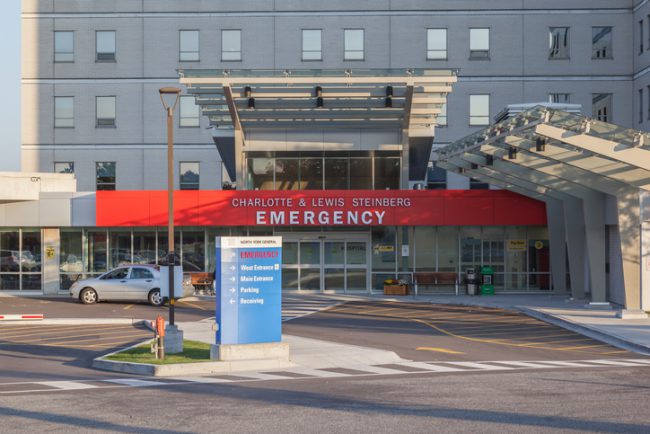Canadians who suffer a stroke are significantly more likely to die if they’re treated in a rural hospital compared to a larger urban hospital, according to a Université Laval study published in the journal PLOS One.

For the study, researchers compared the mortality rates of stroke sufferers in the 30 days following a stroke in 24 urban and 286 rural hospitals between 2007 and 2011, using data obtained from the Canadian Institute for Health Information.
They found the mortality rate to be around 20 per cent higher in patients admitted to rural hospitals, defined as hospitals serving communities of 10,000 residents or less.
That’s a serious problem because one in five Canadians lives in rural areas, the study points out. Around 62,000 strokes occur in Canada each year, and stroke is the third leading cause of death in this country, according to the Heart & Stroke Foundation.
READ MORE: New surgical procedure for stroke patients means lower mortality and improved outcomes
“Our study raises questions about the principles of our universal healthcare system, which stipulate that all Canadians, regardless of their place of residence, have an equal right to quality health care,” said lead researcher Dr. Richard Fleet.
“It might be time to address the inequities in health care in rural areas.”
CT scanner shortage
One of the underlying problems is that less than 11 per cent of rural hospitals have a CT scanner, and only around one in five has an intensive care unit.
“The CT scanner is really a basic tool that you would expect to have access to when you walk into an emergency department with these symptoms,” Fleet told Global News. “Not having this device on hand in the hospital deprives doctors of a tool that can help them quickly diagnose a stroke so they can immediately begin the recommended treatment.
“If you don’t have a CT scanner, you can’t follow the Heart & Stroke Foundation recommendation which is to have a CT scan done within 30 minutes of the patient’s arrival when symptoms suggest that they had a stroke.”
WATCH: New report says stroke survivors not getting enough care

Quebec hospitals weren’t included in the analysis because the province didn’t provide data for the study period, but a previous study by Fleet’s team showed that Quebec’s rural hospitals are better equipped than those in other provinces, with 78 per cent of rural hospitals in Quebec equipped with CT scanners.
Proximity problem

Get weekly health news
Most Canadians live within a six-hour drive of a stroke centre, according to a 2017 study published in the Canadian Medical Journal.
However, Canada’s geography, landscapes and climate make it nearly impossible to get all patients to hospital in early enough time frames for treatment, study co-author Patrice Lindsay wrote in a blog post for the Heart & Stroke Foundation.
READ MORE: Where you live in Ontario may determine your chance of surviving heart attack, stroke
Treatments such as the clot-busting drug alteplase can minimize the effects of stroke if administered within four and a half hours of the first symptoms, Lindsay notes. Newer treatments like endovascular therapy can extend treatment times to six hours, but require doctors with specialized equipment and training.
This issue could be addressed by better serving the equipment needs of rural hospitals, Fleet says, and by improving processes and protocols for inter-facility transfer of patients.
Telemedicine for rapid diagnosis
Aside from more CT scan machines and better education, another important solution could be the wider implementation of telemedicine programs.
Some provinces have telestroke programs that allow rural doctors to contact neurologists, and allow emergency department physicians to consult neurologists in real time. But many rural hospitals still haven’t been set up to take advantage of modern communications technologies to improve patient care.
“We think that if you equip rural emergency departments better, support them better with telehealth and telestroke, you probably will improve your outcomes,” Fleet said.
To that end, the Society of Rural Physicians of Canada and the College of Family Physicians of Canada published a strategic report in 2017 outlining ways to improve health care access for rural Canadians. The implementation of telemedicine programs was a key recommendation in that report.
READ MORE: Alberta halves time it takes to diagnose and treat stroke patients
The Université Laval study suggests looking south of the border for inspiration. The U.S. designates rural acute care general hospitals as Critical Access Hospitals if they are located in a rural area, offer 24/7 emergency care services and are located more than 55 kilometres from the nearest major hospital.
These hospitals appear to have improved access to imaging and other medical services.
“These critical care access hospitals are in reality very similar to Canada’s rural hospitals, and Canada’s discrepancy in access to care is thus particularly reprehensible given its claim to a universal-access health care system,” reads the study.
Responding to a stroke
Until more rural hospitals get access to CT scanners and telestroke networks, Canadians can take certain measures to improve post-stroke outcomes.
Studies suggest stroke outcomes can be improved if Canadians take a more proactive and informed approach to responding to possible strokes. Every minute counts, because 1.9 million brain cells die for every minute a stroke goes untreated.
Emergency department data suggests that only 59 per cent of stroke sufferers come to hospital via ambulance — the “safest and most efficient way to get to an appropriate hospital and receive the best care,” according to a 2015 report by the Heart & Stroke Foundation.
WATCH: Ask The Doctor: How to avoid having a stroke

Health Canada notes the following main warning signs and symptoms of stroke:
- weakness on one side of your body
- numbness or tingling in your face, arm or leg
- trouble speaking or understanding what others say
- vision problems, such as double vision or being unable to see, especially in one eye
- dizziness, such as losing your balance, especially if you are also showing other signs
Canadians are advised to immediately call 911 or their local emergency number if any of these warning signs are spotted.








Comments